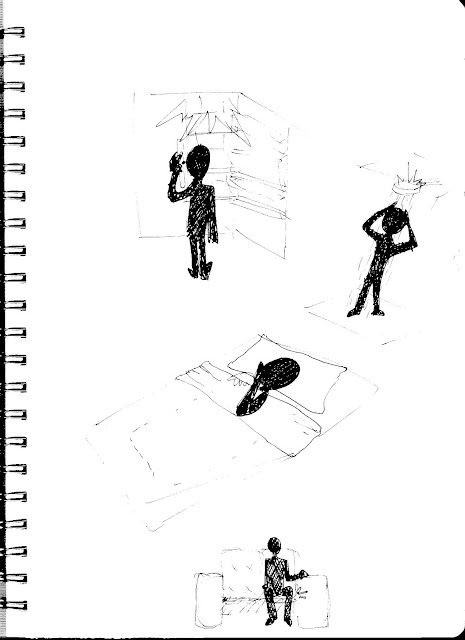Separately have gone away to come up with 4 concepts each for individual products. 2 for the lounge room and 2 for the kitchen. These are the two spaces which we worked out to be the most commonly used spaces between housemates. Due to the interaction, routine, and occurrences in these spaces there is the most opportunity for experiences and memories in which we can aim to recreate.
The goal of each of our concepts is to find a way in which to allow ex-housemates to be reminded or revisit certain aspects of experiences that they once shared.
I must say i found this process very difficult. Coming up with 4 concepts was very challenging, and I found it hard to know when I was heading off track or missing the point. And we have been tweaking our main overarching concept for a while know, so I had to keep in mind that the idea of coincidence and swarm were both no longer relevant.
CONCEPT 1.
The first one is an attachment to work with any fridge within a home. The soft padded piece is stuck onto the inside/back of the fridge handle, by its adhesive surface. Inside the piece is a pressure sensor which feels when someone is constantly opening and closing the door or when they are standing there with the door open for a period of time. The product relies a bit on coincidence. If the other person happens to open their fridge door at the same time, their product will generate warmth onto the surface of the product that is on contact with the hand. This indicates to the person that the other person is also at the fridge and has been there for a while. This concept aims to bring back a particular fondness of the person like their indecisiveness, constantly looking for something to eat, never pleased with whats there or just going to the kitchen due to boredom.
The rough prototype found that the shape and cushioning material was comfortable to use. The form was unobtrusive and fit easily under the hand. The problem with the shape though is that it is not a universal design in that it does not fit with narrower fridge handles.
CONCEPT 2.
The next one is based around the occurrence of entertaining and socialising. The product is designed to be an ornamental centre piece of the table. It is a kind of plate or cutting board that communicates between houses. When one person is having people round it is translated through the device over to the other person's. When cheese is being sliced, the surface underneath it recognises either the pressure or the movement or proximity of the hands and signifies its usage by lighting up the other device through a gentle glowing.
The prototype for this one was extremely simple. Perhaps to simple to get enough relevant feedback from testing and trialling. The dimensions of the prototype are very poorly thought out. Would have to be made wider in length and lower to the table.
CONCEPT 3.
The third concept is only really relevant to those who have a habit of constantly flicking through channels the ads on TV. A special remote encourages this behaviour. After a certain amount of time of one person keeping on flicking through it alerts the other user. By any means such as, flicking the channels on the other TV, beeping or some kind of noise or vibration or humming.
The paper model was too geometric and bulky for trial users to handle in a natural way. The one button makes it easy to use. The button would be best extruded or indented into the casing with a textural surface to enable thumb to rest there, and able to be used when not looking at it. The model was to thick for users to be able to get their thumb all the way to press their button. Ergonomic data would be required here.
CONCEPT 4.
The final concept is for kitchen. It is to be used in situations of waiting in the kitchen. Where housemates would have once passed time together eg. waiting for the microwave, cooking or for some one to finsih with a partiular peice of equipment. It is a tangible object that is able to be manipulated and reformed by hand. It is acts as a distraction to help pass the time.
It was difficult to transfer the qualities of the written concept to a prototype. The movements and manipulation were not the same or as easy as was initially planned through the concept design. The thin components that make up the form were seen to be a good feature as this enabled users more flexibility.













































.jpg)


.jpg)
.jpg)